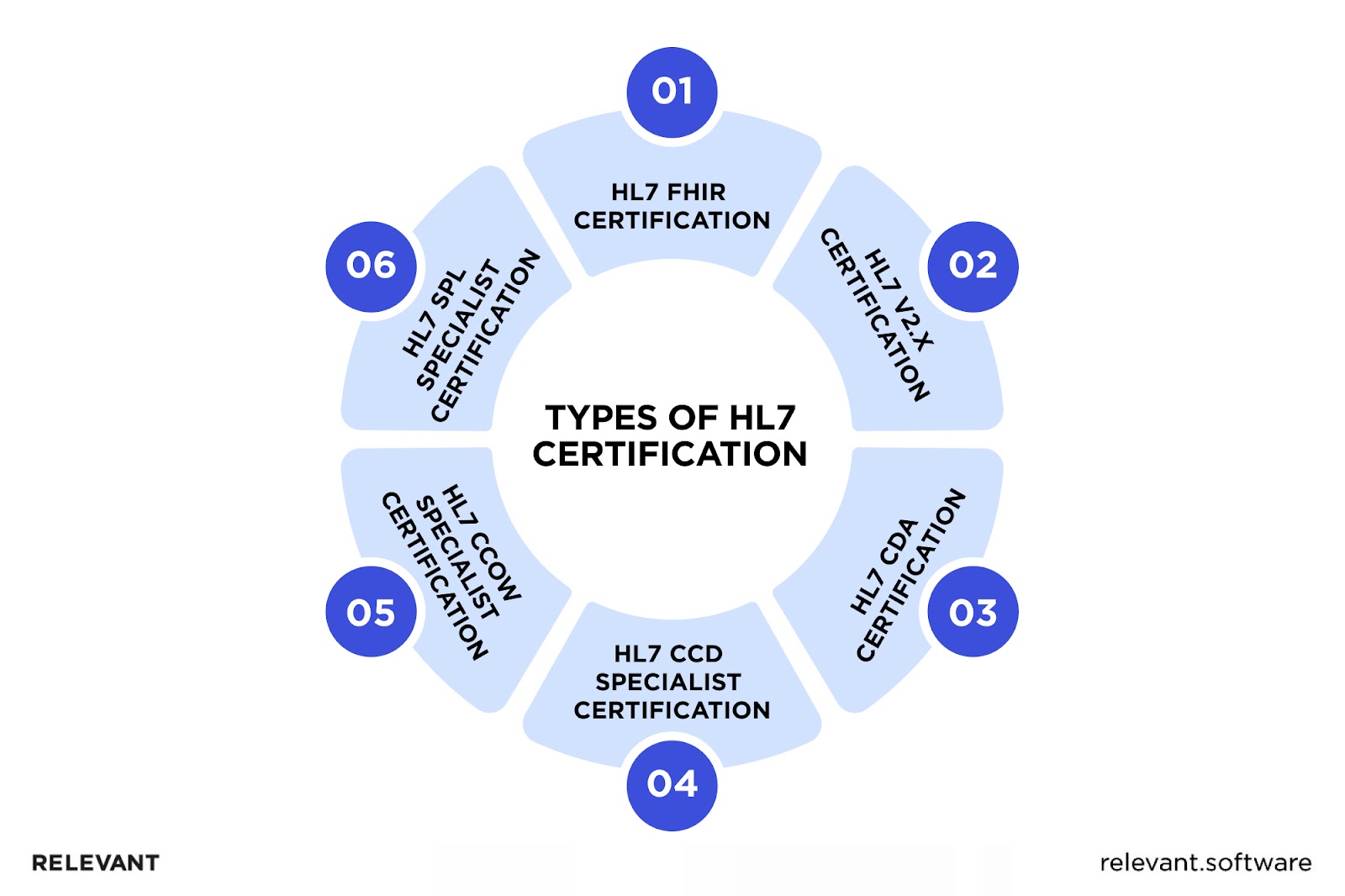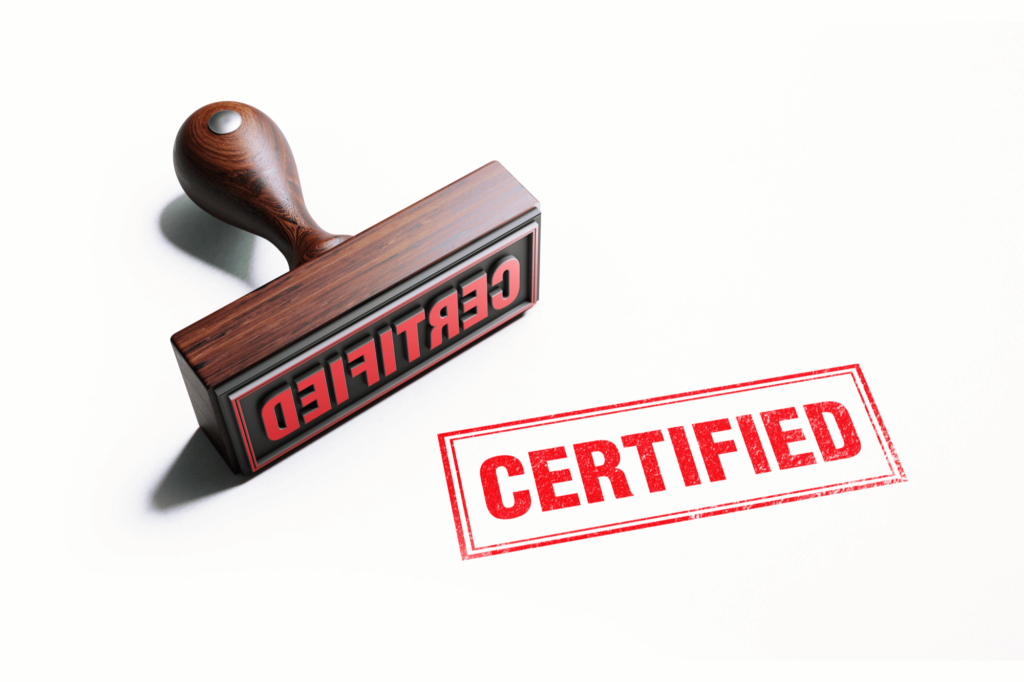Comprehensive Exploration of HL7 Certification
Updated: June 4, 2025
Within the multifaceted world of healthcare information technology, securing HL7 certification marks a pivotal achievement for those dedicated to refining the standards of healthcare data interchange. This certification, crafted by Health Level Seven International, is more than just a benchmark of proficiency in interpreting and managing healthcare data. It’s a tangible commitment to enhancing communication channels within the diverse landscapes of healthcare ecosystems.
In this article, we’re going to explore every facet of HL7 certification – its types, its benefits, and the process of its obtaining for healthcare IT professionals. We aim to illuminate its crucial role in pushing the boundaries of interoperability and raising the bar for healthcare delivery systems across the globe.

We provide companies with senior tech talent and product development expertise to build world-class software. Let's talk about how we can help you.
Contact usTable of Contents
What Is HL7?
Let’s take a moment to consider the complexity of healthcare systems. These systems form intertwined networks, heavily dependent on the uninterrupted flow of information to provide the highest level of patient care. That’s where HL7 comes into play – a standardized protocol designed to meet this critical need. It serves as a reliable framework for the secure and streamlined transmission of health-related data across various IT applications and systems.
With HL7, patient details and other vital healthcare information don’t get stuck in one part of the system. Instead, they flow where they’re most urgently required. This fluidity means medical experts can tap into the info they need quickly, ensuring outstanding care without a hitch.

Now, let’s dive a little deeper. HL7 is not just one standard – it’s a whole family! Among the most notable are HL7 Version 2, HL7 Version 3, and the rapidly evolving HL7 FHIR (Fast Healthcare Interoperability Resources). FHIR is particularly interesting because it brings in modern web technologies and emphasizes simplicity and interoperability, making it easier to connect different healthcare systems.
It’s exciting to see how HL7 continues to evolve. A community of dedicated professionals – from developers to healthcare providers to IT experts – all working together to make HL7 better and better, adapting to the changing healthcare needs and rising to meet new challenges.
HL7 Standards
Here’s the thing about HL7 Standards – they aren’t a one-size-fits-all. Instead, it’s a broad spectrum of protocols tailored to various facets of healthcare information communication.
FHIR (Fast Healthcare Interoperability Resources)
If you’ve been tuned into recent healthcare tech talks, you’ve probably heard of FHIR. It’s like the fresh face in the HL7 family. What makes it stand out? Well, SMART on FHIR taps into contemporary web technologies, putting simplicity and connectivity at the forefront. It’s no wonder many are praising it as the next big thing for easily interconnecting diverse healthcare systems.
V2.x Messaging Standard
Also, let’s mention the V2.x Messaging Standard. It’s been around as a tried-and-true method for digitizing health data. It’s the reliable workhorse in our toolbox of HL7 standards, consistently ensuring diverse healthcare systems chat seamlessly.
Clinical Document Architecture (CDA)
Switching gears slightly, we have the Clinical Document Architecture, more briefly known as CDA. This isn’t just about data but the structure of clinical documents. By promoting uniformity in how these documents are crafted and shared, CDA helps paint a clearer picture for healthcare professionals, no matter which system they’re accessing the info from.
Role of HL7 Standards in Modern Healthcare
Now, for the big question: Why should we even care about HL7 Standards today? Well, as our world becomes more interconnected, these flexible standards, directives, and techniques laid out by HL7 International are the glue binding the health tech community. By promoting seamless communication, reducing data roadblocks, and elevating patient care’s overall efficiency, HL7’s importance in contemporary healthcare is not just notable—it’s downright essential.
HL7 Certification: Overview
For professionals seeking to step into this domain, HL7 certification training is a gateway to acquiring essential skills and demonstrating proficiency in this vital area of healthcare technology. The question often arises: is HL7 certification worth it? The answer is a resounding yes for those aiming to make substantial contributions to healthcare interoperability.
Types of HL7 Certification
To meet the diverse needs of healthcare IT, several types of HL7 certification are available, each focusing on a specific aspect of HL7 standards.

HL7 FHIR Certification
Pioneering the way forward, HL7 FHIR certification is a cornerstone for those looking to specialize in Fast Healthcare Interoperability Resources. This certification validates expertise in leveraging modern web technologies for healthcare data exchange and demonstrates a comprehensive understanding of fostering connectivity and simplicity in healthcare systems.
HL7 V2.x Certification
A staple in the HL7 family, the HL7 V2.x Certification is integral for professionals aiming to master the widely adopted V2.x Messaging Standard. It signifies proficiency in facilitating communication between diverse healthcare systems, thereby enhancing the electronic exchange of health data.
HL7 CDA Certification
Focusing on the structure of clinical documents, the HL7 CDA Certification is vital for ensuring uniformity and standardization in clinical document architecture. Acquiring this certification signifies a commitment to promoting clarity and accessibility of patient information across different systems.
HL7 CCD Specialist Certification
For those with a keen interest in Continuity of Care Documents, the HL7 CCD Specialist Certification is the pathway to becoming an expert in this field. It showcases one’s skills in creating and managing documents that are integral to ensuring continuity of care.
HL7 CCOW Specialist Certification
HL7 CCOW Specialist Certification is tailored for individuals aiming to specialize in Clinical Context Object Workgroup standards. This certification validates the ability to integrate applications at the point of care, providing a unified view of patient information.
HL7 SPL Specialist Certification
Last but not least, the HL7 SPL Specialist Certification is designed for those looking to focus on Structured Product Labeling. This certification demonstrates mastery in creating and managing detailed product information, aligning with regulatory requirements, and fostering patient safety.
Acquiring HL7 certification is not just about validation but also about deepening one’s understanding and enhancing skills in the specialized sectors of healthcare information technology. Whether it’s HL7 RIM certification or HL7 v3 certification, each type offers a unique avenue to contribute significantly to the field.
Benefits of Achieving HL7 Certification
The acquisition of this esteemed certification brings forth a plethora of benefits that extend beyond the individual to the healthcare system at large.
Enhancing EHR Technology Across Various Systems
One of the principal advantages of this certification is its capacity to bolster EHR technology. It ensures that the technology is interoperable and proficient in communicating seamlessly across various systems. This enhancement is pivotal, improving healthcare delivery efficiency and augmenting patient safety by offering a comprehensive and integrated view of medical histories. Moreover, the certification confirms adherence to industry standards, aiding healthcare professionals in mitigating costly errors and optimizing patient outcomes.
Facilitation of Interoperability
HL7 FHIR Certification is instrumental in advancing interoperability. It empowers organizations and healthcare practitioners to align with industry standards and adopt best practices, indispensable in the dynamic landscape of modern healthcare. The ability to facilitate seamless communication between systems translates to heightened efficiency, diminished errors, and enriched patient outcomes.
Amplification of Understanding in Medical Coding and Data Standards
This certification serves as a means to deepen the understanding of the myriad codes and standards prevalent in the medical sector. Such understanding is fundamental for the delivery of accurate and efficacious care. HL7 FHIR Certification enables individuals to grasp the organization of medical data and harness it to enhance patient care. Staying abreast of the latest developments in medical coding and data standards becomes attainable, ensuring the provision of optimal care.
Elevation of Professional Credibility
Achieving HL7 FHIR Certification is a testament to one’s commitment to interoperability and patient-centered care, subsequently enhancing organizational and individual reputation among diverse stakeholders. Adherence to FHIR standards keeps professionals updated with evolving best practices and standards, augmenting their credibility and expertise in the field.
Demonstrating Compliance with Standards and Best Practices
HL7 FHIR Certification underscores a commitment to a standardized approach in exchanging health information across diverse healthcare systems. This uniformity is crucial, making information sharing more efficient and elevating the overall quality of patient care. By adopting HL7 FHIR, healthcare providers assure adherence to contemporary best practices and guidelines, ensuring reliable and secure communication across systems.
In conclusion, HL7 Certification, particularly in FHIR, serves as a backbone of proficiency and commitment in healthcare IT, enhancing interoperability, adherence to standards, and overall quality of care in the ever-advancing healthcare landscape.
The Certification Process
So, you ask, “How do I get HL7 certification”? It begins with a commitment to learning, exploring available training options, and selecting the certification that aligns with your career goals. Ultimately, HL7 training and certification open doors to opportunities, enabling professionals to play a pivotal role in advancing healthcare interoperability and delivery. Here’s a breakdown of the steps and aspects you need to be familiar with:

Application Requirements
There are certain prerequisites you must meet to embark on the journey toward HL7 FHIR Certification:
- Prior Knowledge: Before engaging in Foundation Level FHIR Training, a foundational understanding of HL7 FHIR is paramount. That ensures you’re grasping the basics before diving into advanced concepts.
- Technical Proficiency: While the certification is broad-reaching, it’s highly recommended for applicants to have a working familiarity with programming languages like C#, Java, and JavaScript. This technical grounding is especially beneficial for developers seeking the certification.
Exam Structure
The certification examination is designed to test your breadth and depth of understanding:
- Format: The HL7 FHIR certification exam is structured with 75 multiple-choice questions.
- Duration: Every candidate is provided with a 2-hour window to tackle the examination.
- Passing Criteria: To secure the certification, scoring 70% or above is non-negotiable. The availability of an online format for the exam introduces a level of flexibility for candidates around the world.
Study Material and Preparation Tips
A thoughtful and well-rounded preparation strategy is your ticket to success in the certification exam:
- Training: Enrolling in a 2-day, instructor-led FHIR training is prudent. Led by professionals with HL7 certification, these sessions provide invaluable insights. They go beyond mere theoretical input; expect a mix of interactive discussions and hands-on exercises to deepen your grasp and recall of the subject matter.
- Resources: Registration on the HL7 website unlocks a lot of resources and tools, all curated to aid candidates on their certification journey. Utilizing these resources is a smart move, integrating them into a well-rounded study approach.
- Costs: The financial commitment for the HL7 FHIR certification exam is variable. The range is broad, with prices between $500 and $3000, depending on your location and chosen training provider. This expenditure is an investment in your professional development and credentialing.
Continuing Education and Recertification
Stagnation has no place in the dynamic field of healthcare IT. Earning your initial certification is a commendable milestone, but the learning curve continues. HL7 advocates for ongoing education and routinely hosts a variety of training sessions, workshops, and seminars.
Participation in these educational opportunities is essential to stay abreast of industry evolution. It can pave the way for recertification or achieving advanced certifications such as HL7 2.8 certification, HL7 interface certification, or HL7 CDA certification, catering to specialized roles.

Practical Applications of HL7 Standards
Understanding the HL7 standards is fundamental for healthcare professionals striving to enhance the efficiency and efficacy of healthcare information technology. These standards are pivotal in addressing the diverse challenges that arise in integrating and managing clinical data across various platforms and systems.
Enhancing Patient Care Through Interoperability
The role of HL7 standards in boosting interoperability between distinct healthcare IT systems is invaluable. By ensuring the efficient swap of clinical data, these standards grant healthcare professionals swift access to comprehensive patient information, enhancing the decision-making process, customizing treatments, and elevating patient care quality. The interoperability brought about by HL7 also diminishes redundancy and lowers the probability of errors, streamlining the healthcare delivery process.
Challenges and Solutions in Implementations
Although HL7 standards bring forth many advantages, their implementation comes with its own challenges.
Healthcare organizations might confront issues related to system compatibility, safeguarding of data, and system updates. However, these issues can be successfully navigated by strategically planning, utilizing additional resources, and choosing the right training provider. Having a detailed architecture document and acquiring knowledge in clinical document architecture is indispensable for healthcare professionals aiming to grasp the technology and adeptly implement HL7 standards, thus surmounting any potential obstacles.
In wrapping up, HL7 standards’ practical applications are vast and fundamental to the progression of healthcare information technology. By addressing the challenges associated with implementation and committing to ongoing learning, healthcare professionals can harness the capabilities of HL7 to improve patient care and system interoperability markedly.
HL7 Certification: Final Words
While discussing the significance of standards and certification is vital, emphasizing the value of partnering with a trustworthy provider for implementing these standards in your healthcare organization is equally crucial. Why does this matter?
In essence, a dependable provider ensures smooth integration, mitigating potential challenges and enhancing the efficacy and quality of healthcare delivery. In a few words, it’s about fostering reliability and optimizing outcomes.
Engage with Relevant Software for HL7 FHIR implementation, and you’re choosing innovation, bespoke solutions, and a pathway to improved patient care. Our tailored approach to healthcare software development aligns with your unique demands, aiming to elevate your position in the digital health landscape.
By simplifying complex processes and adopting best practices, we overcome implementation hurdles and expedite the embrace of modern technologies. Partnering with us means bolstering your operations and unlocking the potential to deliver exceptional, personalized healthcare.
FAQ
Our core services:
Do you want a price estimate for your project?
Do you know that we helped 200+ companies build web/mobile apps and scale dev teams?
Let's talk about your engineering needs.
Write to us











